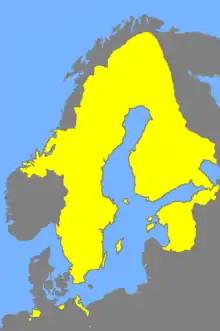| Russo-Swedish War of 1656–1658 | |||||||||
|---|---|---|---|---|---|---|---|---|---|
| Part of the Second Northern War | |||||||||
| |||||||||
| Belligerents | |||||||||
|
|
| ||||||||
| Commanders and leaders | |||||||||
| Strength | |||||||||
| 42,000–45,000[6] | 25,000 | ||||||||
| Casualties and losses | |||||||||
| 5,000–16,500 killed, wounded or captured[7][8] | 13,000 killed, wounded or captured[9] | ||||||||
The Russo-Swedish War of 1656-1658 was fought by Russia and Sweden as a theater of the Second Northern War. It took place during a pause in the contemporary Russo-Polish War (1654–1667) as a consequence of the Truce of Vilna. Despite initial successes, Tsar Alexis of Russia failed to secure his principal objective—to revise the Treaty of Stolbovo, which had stripped Russia of the Baltic coast at the close of the Ingrian War.
Background
When Charles X Gustav of Sweden invaded Poland, captured Warsaw and announced his claims on the Russian conquests in the orbit of the Grand Duchy of Lithuania, Afanasy Ordin-Nashchokin (who led Russian diplomacy at the time) decided it was an opportune time to suspend hostilities against the weakened Polish–Lithuanian Commonwealth and to attack the rear of the Swedish Empire instead. To that end he opened negotiations and concluded a truce with Poland in summer 1656 (the Truce of Vilna, also known as the Truce of Niemież), a move which enraged a major ally of Russia, Ukrainian hetman Bohdan Khmelnytsky who maintained good relations with Sweden and was fighting against Poland.
Campaigns

In July, a reserve force of the Russian army struck across Swedish Ingria and overran two key Baltic fortresses — Nöteborg and Nyen. A separate detachment advanced on Dorpat (Tartu), which fell in October. The main forces marched along the bank of the Western Dvina towards Riga, taking Daugavpils (see Siege of Dyneburg) and Koknese (see Storm of Kokenhusen) on their way. By the end of August, the capital of Livonia was besieged and bombarded.
As Russia had no full-fledged navy to intercept reinforcements coming to the Swedish garrison across the Baltic, Riga managed to hold out until October, when foreign officers commanding a small Russian flotilla defected to the other side and the Russians had to lift the siege. In the aftermath of this reverse, the Swedes recaptured much of Ingria, took the Pskov Monastery of the Caves and inflicted a defeat on the Russian general Matvey Sheremetev at Walk (Valga) in 1657, but were eventually defeated by another Russian general, Ivan Khovansky, at Gdov, on 16 September 1657.
Conclusion
By the end of 1658, Denmark was knocked out of the Northern Wars and the Ukrainian Cossacks under Khmelnytskyi's successor, Ivan Vyhovsky, allied themselves with Poland, changing the international situation drastically and inducing the tsar to resume the war against Poland as soon as possible. Under such circumstances, it was necessary to bring the Swedish adventure to a speedy end. On 20 December, Ordin-Nashchokin negotiated with Sweden the Treaty of Valiesar (Vallisaare), whereby Russia was allowed to keep the conquered territories in present-day Latvia and Estonia — Koknese, Aluksne, Dorpat, Nyslott — for three years.
When the term expired, Russia's military position in the Polish war had deteriorated to such a point that the tsar could not allow himself to be involved into a new conflict against powerful Sweden. His boyars had no other choice but to sign in 1661 the Treaty of Kardis (Kärde), which obliged Russia to yield its Livonian and Ingrian conquests to Sweden, confirming the provisions of the Treaty of Stolbovo.[4] This settlement was observed until the Great Northern War broke out in 1700.
See also
References
- ↑ Sundberg, Ulf (2002). Svenska krig 1521-1814 (in Swedish) (2nd ed.). Stockholm: Hjalmarson & Högberg. p. 221. ISBN 9789189080140.
- ↑ KISER, EDGAR, et al. “THE RELATIONSHIP BETWEEN REVOLT AND WAR IN EARLY MODERN WESTERN EUROPE.” Journal of Political & Military Sociology, vol. 22, no. 2, 1994, pp. 305–24. JSTOR, http://www.jstor.org/stable/45371312. Accessed 6 Dec. 2023.
- ↑ https://web.archive.org/web/20071013161021/http://smb.nu/svenskakrig/1656.asp
- 1 2 Gillespie, Alexander (2021-01-14). The Causes of War: Volume IV: 1650 - 1800. Bloomsbury Publishing. ISBN 978-1-5099-1218-6.
- ↑ Palmer, William (1871). "Testimonies concerning the patriarch Nicon, the tsar, and the boyars, from the Travels of the patriarch Macarius of Antioch, written in Arabic by his son and archdeacon Paul of Aleppo".
- ↑ Kurbatov, O. A. (2009). Рижский поход царя Алексея Михайловича 1656 г.: Проблемы и перспективы исследования [The Riga Campaign of Tsar Alexey Mikhailovich in 1656: Problems and Prospects of Research]. In Pikhoya, R. G. (ed.). Проблемы социальной и политической истории России: Сборник научных статей [Problems of the Social and Political History of Russia: A Collection of Scientific Articles] (in Russian). Moscow: RAGS Publishing House. pp. 83–88.
- ↑ S. S., Yermolayev, ed. (2007). Архив русской истории: Сборник Российского государственного архива древних актов. Выпуск 8. [Archive of Russian History: A Collection of the Russian State Archive of Ancient Documents. Issue 8.] (in Russian). Moscow: Drevlekhranilishche. ISBN 978-5-93646-122-4.
- ↑ Isacson, Claes-Göran (2002). Karl X Gustavs krig: Fälttågen i Polen, Tyskland, Baltikum, Danmark och Sverige 1655–1660 [Charles X Gustav's War: The Campaigns in Poland, Germany, the Baltics, Denmark and Sweden 1655–1660] (in Swedish). Lund: Historiska Media. ISBN 91-89442-57-1.
- ↑ Fagerlund, Rainer (1979). Kriget i Ostersjoprovinserna 1655–1661: Operationer och krigsansträngningar på en bikrigsskådeplats under Carl X Gustafs krig [War in the Baltic Provinces 1655–1661: Military Operations and War Costs in a Subsidiary Theatre During the Wars of Charles X Gustavus]. Carl X Gustaf-Studier 7:1 (in Swedish). Helsinki: Militärhistoriska förlaget. ISBN 91-85266-10-8.
This article incorporates text from a publication now in the public domain: Brockhaus and Efron Encyclopedic Dictionary (in Russian). 1906. {{cite encyclopedia}}: Missing or empty |title= (help)